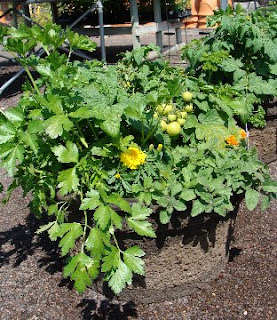 No room for a vegetable garden? Try one in a container. You can enjoy fresh tomatoes easily this way. Even small space gardeners can grow enough nutritious produce to prepare a few meals, supplement your diet, and save some bucks. With a little planning and attention, container gardens can produce like mini farms. Almost any vessel can be used as a container, but it must have drainage holes that allow water to freely flow through the pot. Most veggies only need 8” of soil depth. Trays and smaller containers work fine for lettuce, radishes, spinach, and peppers. Root crops like carrots and onions, and large plants like most tomatoes and squash, require containers larger than 16 inches in diameter. Generally as a rule, bigger is better for root growth and overall vigor.
No room for a vegetable garden? Try one in a container. You can enjoy fresh tomatoes easily this way. Even small space gardeners can grow enough nutritious produce to prepare a few meals, supplement your diet, and save some bucks. With a little planning and attention, container gardens can produce like mini farms. Almost any vessel can be used as a container, but it must have drainage holes that allow water to freely flow through the pot. Most veggies only need 8” of soil depth. Trays and smaller containers work fine for lettuce, radishes, spinach, and peppers. Root crops like carrots and onions, and large plants like most tomatoes and squash, require containers larger than 16 inches in diameter. Generally as a rule, bigger is better for root growth and overall vigor.
Take your houseplants outdoors once the evening temperatures will remain above 50°. Move sun-loving plants (hibiscus, gardenias, mandevillas, etc.) gradually to sunny locations, as they have not had full sun in your home and will need to be acclimated to those conditions.
Plant summer bulbs now and fertilize with bone meal or bulb food. Pinch hardy garden mums back now and continue to do so until July 4 to insure proper fall blooming. Treat slugs in your garden with organic diatomaceous earth. This powder product is 100% safe, and is good for the treatment of slugs, ants, fleas and ticks outside, as well as roaches and ants indoors. This organic product is very safe to use and a good one to have on hand. “Natural Gardening” with eco-friendly products is a very SAFE thing to do for your own health as well as the environment. Check out the chemical-free options available to you today. Then sit back and watch your kids and pets enjoy the beautiful outdoors.
“Coming home” at the end of a day can be even more important to us now than ever before. Times are changing and everyone is busier than before with kids to coach, meetings to attend, and work to do. In addition, the cost of gas makes us want to leave the car parked when possible. So, enjoy daylight savings time and extend your living quarters to your yard and garden. Think of your outdoor spaces as an extension of your home. And in doing so, consider the floor, walls, and ceiling per se. Adding resting areas is easy to do…hang a hammock in a tree, set a bistro set in the perennial garden, or put benches in your Hosta beds. Then invite friends over and have a cook out. Let the nature in your yard tickle your senses with the sounds of birds, fragrance of flowers, sounds of running water, and splashes of color. Hardscapes can enhance your outdoor rooms by adding a “floor” to your area of enjoyment.
Until next month,…Enjoy connecting with nature and….see you in the garden….
Sandi Hillermann McDonald

